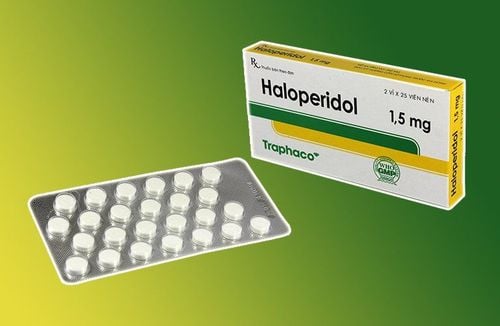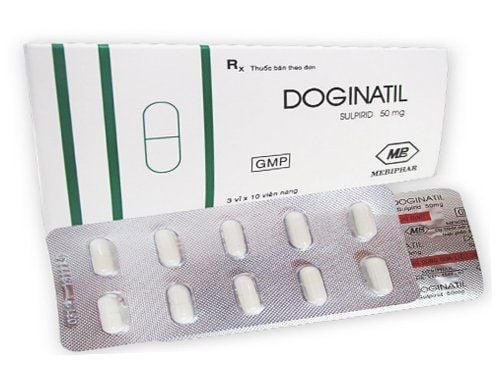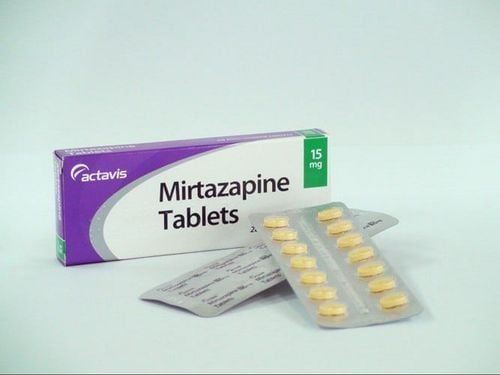This is an automatically translated article.
What is Dogracil? Dogracil is a drug used in the treatment of mental and behavioral disorders with the main ingredient being Sulpiride. To learn more about the use of Dogracil and the most important information, please read the following article.
1. Uses of Dogracil
Sulpiride is an active ingredient of the benzamide group, which is highly effective in combating psychosis thanks to the mechanism of selective blockade of dopamine D2 receptors in the brain. Sulpiride does not cause drowsiness or emotional eyes like the classic neuroleptics (phenothiazines or butyrophenones).This is why Sulpiride is indicated for use in:
Short-term treatment of symptoms of anxiety in adults who cannot respond to standard treatment. Treatment of mental disorders in physical diseases. Inhibitory nervous state. Severe behavioral disorders: Self-injury, excessive agitation, stereotyping in children over 6 years of age, especially in the context of autism spectrum disorder. Dogracil is contraindicated in the following cases:
Patients with hypersensitivity or allergy to any of the excipients and active ingredients in the drug. Patients with adrenal myeloma, with acute porphyria metabolism disorder. Patients with depressed central nervous state, alcohol poisoning, coma and neuroleptic drugs.
2. Dosage and usage
2.1. Dosage Dosage for adults:
Negative symptoms of schizophrenia : Start with a dose of 200-400mg / time, taken twice a day, if necessary it can be increased to a maximum dose of 800mg / day . Positive symptoms of schizophrenia: Start with 400mg/time, take 2 times a day, then gradually increase to a maximum dose of 1200mg/time, take 2 times a day. Combined negative and positive symptoms: Use at a dose of 400-600mg/time, 2 times a day. Dosage for children:
Children over 14 years old: Take a dose of 3-5mg/kg/day. Children under 14 years of age: There is no indicated dose. Elderly people: Start with a dose of 50-100mg / time, take 2 times a day, then gradually increase to an effective dose.
Patients with renal impairment : It is necessary to reduce the dose or increase the interval between dosing, depending on the creatinine clearance.
Creatinine clearance 30-60 ml/min: Use a dose equal to 2/3 of the normal human dose. Creatinine clearance 10-30 ml/min: Use dose equal to 1/2 of the normal human dose. Creatinine clearance less than 10ml/min: Use a dose equal to 1/3 of the normal dose. In addition, patients can increase the interval between doses by 1.5, 2 and 3 times compared to the normal dose. However, if possible, in moderate to severe renal impairment, sulpiride should be limited.
3. Note when using
Care should be taken to reduce the dose, and at the same time should not be treated continuously and for a long time in patients with renal failure. Use with caution in people with epilepsy, because there is a possibility that the seizure threshold will be lowered. Use caution when using the drug for the elderly, because this age group is prone to drowsiness, orthostatic hypotension and is easily lowered. Use with caution in people with hypomanic episodes, because low doses of sulpiride have the potential to make symptoms worse. The drug crosses the placenta and is distributed into breast milk, can cause unwanted side effects on the nervous system of the fetus and breastfed child. Therefore, women who are pregnant and breastfeeding. should not be taken, especially during the first 16 weeks of pregnancy.
4. Side effects
During the use of Sulpiride, patients may experience unwanted side effects:
Common: Nervous system causes insomnia or drowsiness, endocrine system increases lactation, increases ptolactin in the blood, menstrual disorders or amenorrhea. Uncommon: On the nervous system causes overstimulation, parkinson's syndrome, extrapyramidal syndrome (appearance of rotator cuff muscles, restlessness, torticollis), prolonged QT interval on the heart (torsades de pointes, cardiac arrhythmias) . Rare: In the endocrine system causing gynecomastia in men, in the blood pressure causing orthostatic hypotension, arrhythmia or bradycardia, in the nervous system causing neuroleptic malignant high fever syndrome , other symptoms such as photosensitivity, hypothermia, cholestatic jaundice. Above is important information about the use of Dogracil and the notes to know. To ensure the effectiveness of the drug as well as the safety of the patient, we should only use the drug when prescribed and guided by the doctor, pharmacist.
Please dial HOTLINE for more information or register for an appointment HERE. Download MyVinmec app to make appointments faster and to manage your bookings easily.













